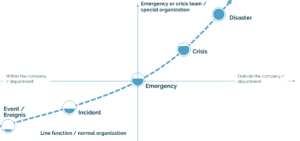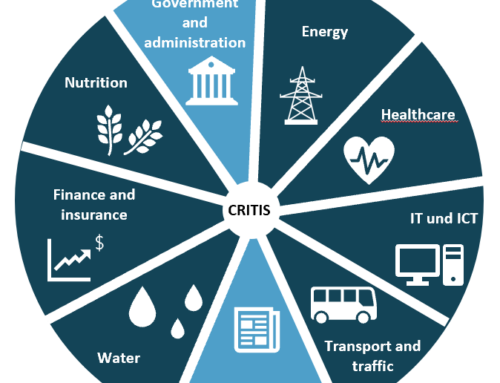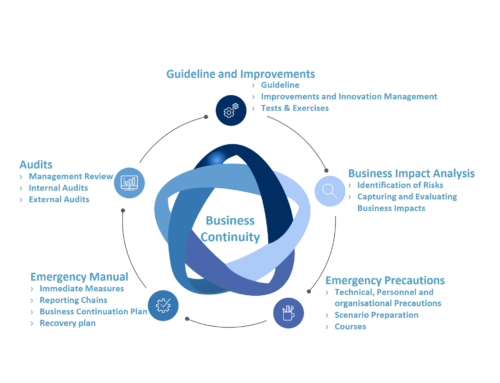The concept of crisis in everyday language use and the actual definition.
Crisis is a frequently used term, but it has different meanings. Similarly, emergency and disaster are often used in different contexts. The map of terms shows the escalation of an event to a disaster.

An event can be evaluated both positively and negatively. This means that the occurrence of an event does not generally cause damage, but can also be an impetus or an opportunity that moves the company forward. For example, a phone call can contain both good and bad news and is evaluated as an event in both cases.
An incident, on the other hand, is the negative escalation of an event. It is a deviation from the normal state, but without causing massive damage. In a company, both an incident and a negative event can be handled with the general organizational structure (line function), i.e. the daily structures and responsibilities.
However, if the incident escalates further, this is referred to as an emergency. DIN EN ISO 22300 defines an emergency as a “sudden, urgent, usually unforeseen occurrence or event that requires immediate action” [1]. These immediate measures also mark the boundary between the general and the special organizational plan. The special organizational structure, for example in the form of an emergency or crisis team, takes over the emergency management according to a defined emergency manual.
The crisis is the next highest escalation level after the emergency. According to DIN CEN/TS 17091, it is characterized as a “novel or exceptional event or situation that poses a threat to an organization and requires a strategic, adaptive and timely response to maintain the organization’s functionality and integrity” [2]. Above all, its existence-threatening character should be emphasized as a characteristic.
The disaster is a further escalation of a crisis, which requires state intervention and affects not only individual companies, but entire regions. For a company, it should therefore be noted that it can be affected by a catastrophe, but that it is only in very few cases the trigger of such a catastrophe. The term crisis can thus be defined as the main term for events in companies with a large amount of damage, many effects and a need for rapid action.
Emergency and crisis management
Emergency and crisis management deals with preparedness and management of crises and emergencies, depending on the escalation level of the event. The figure shows the cycle of crisis and emergency management according to DIN EN ISO 22301, which lists the components of this.

An essential part of crisis and emergency management is the performance of a business impact analysis, also known as BIA, in which risks are identified, evaluated and prioritized. Based on these results, both emergency preparedness and the creation of an emergency manual are necessary.
The purpose of emergency precautions in emergency management is to reduce the identified risks and prepare employees to deal with emergencies. The Global Crisis Survey shows that many companies are expecting a crisis, yet not all are prepared for one. In this context, emergency preparedness is worthwhile, as it provides a new perspective on the company, makes the company more resilient and can be beneficial in other areas as well. Above all, exercises and training courses are useful and helpful in gaining experience and improving emergency management. It is not only about getting to know processes and systems better, but also about bringing the personnel responsible for managing a crisis closer together. Each exercise reduces uncertainty and a basic rule here is that mistakes are allowed.
Once an event has occurred, an exercise is not possible. However, the emergency manual can assist those responsible in managing a situation, providing immediate actions on the one hand and long-term measures for coping on the other. It should be noted that an emergency manual can be created that contains different plans for emergencies. Crises are usually unforeseen, so although a basic crisis manual can be created, this must be general and instead provide structures that facilitate the management of a crisis. Therefore, it is considered more appropriate to focus on basic methodologies for managing any event in emergency and crisis management.
An essential component of emergency management is extensive documentation by appropriate individuals. This documentation is both court-proof in retrospect and can be presented at trial as evidence of how the crisis unfolded, as well as a basis for evaluation that can be used to reflect on the decisions made and how the crisis unfolded. This is particularly relevant for subsequent improvement of crisis and emergency management, because after a crisis, lessons can be learned from the experience of managing it.
To know what completes the BCM cycle, listen in to our Business Resilience Podcast.
Literature
[1] DIN-Normenausschuss Feuerwehrwesen (FNFW); DIN-Normenausschuss Dienstleistungen (NADL); DIN-Normenausschuss Informationstechnik und Anwendungen (NIA). DIN EN ISO 22300:2018, Sicherheit und Resilienz – Vokabular (ISO 22300:2018): Beuth Verlag.
[2] DIN-Normenausschuss Feuerwehrwesen (FNFW). DIN CEN/TS 17091:2018, Krisenmanagement – Strategische Grundsätze. Berlin: Beuth Verlag.
An article written by Anna Müller, published on 27 August 2020
Translated by Charlotte Ley






